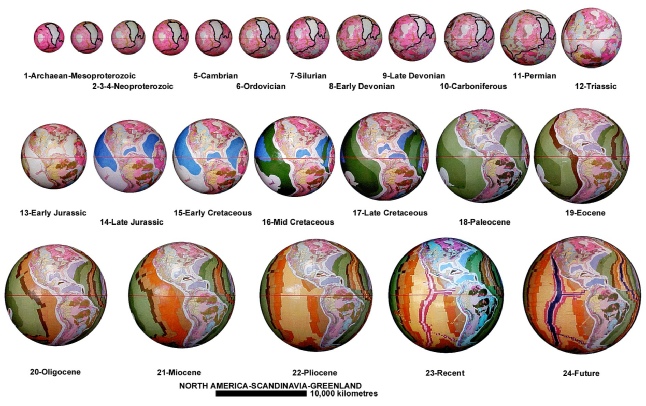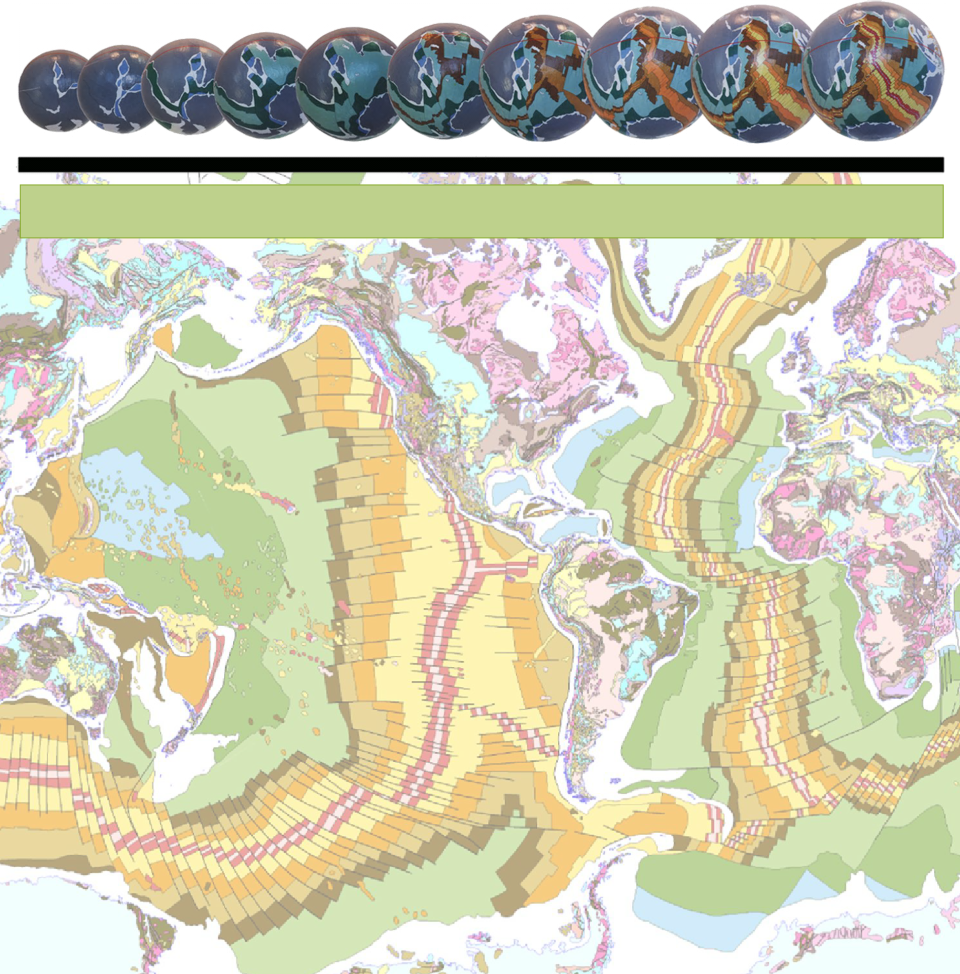NORTH AMERICA
The development of the North American continent is intimately related to a primordial Archaean supercontinent crustal assemblage and its ultimate break-up to form the ancient Canadian, Greenland, and Scandinavian crusts. This cluster of ancient continental crusts is discussed together and is here referred to as the North American cluster. On both plate tectonic and Expansion Tectonic reconstructions this cluster is referred to as the Laurentia and Baltica supercontinents.

The continental crustal development of North America-Greenland-Scandinavia on an Expansion Tectonic Earth. The horizontal red line represents the location of the ancient equator and black lines represent the continental outlines.
On Expansion Tectonic small Earth models the ancient North American cluster of crustal fragments remained intact throughout Palaeozoic and Precambrian times. This cluster straddled the ancient equator, extending from mid-southern to high-northern latitudes. The ancient cluster was assembled against the European and Asian Tethys region to the north, the Australian Proterozoic basins to the west, South America to the southwest, and West Africa to the south and southeast, relative to the ancient equator. Small Precambrian crustal fragments now located within Europe were also clustered adjacent to Greenland and Scandinavia.
In effect, this ancient North American cluster formed a nucleus for surrounding crustal development. The cluster represents exposed elevated lands throughout these ancient times and supplied eroded sediments to surrounding sedimentary basins. The Precambrian and Palaeozoic development of the North American cluster then involved crustal extension and basin sedimentation within a surrounding network of continental sedimentary basins. These basins included links to the Tethys Sea basin to the southeast, as well as basins linked to what is now Russia, China, Australia, and South America to the north, west, and southwest.
This North American cluster remained intact throughout the Precambrian and Palaeozoic times until the Pangaea supercontinental break-up and opening of the North Atlantic Ocean commenced during the late-Permian Period. During opening of the North Atlantic Ocean, Scandinavia and the Baltic region were separated from North America and have since remained attached to Europe during further opening of the North Atlantic and Arctic Oceans.
Breakup and fragmentation of the ancient Pangaea supercontinent began during the late-Permian and by the Triassic the early Arctic, North Atlantic, and North Pacific Oceans had also commenced opening. This breakup and opening of the modern oceans then effectively defined the modern North American continental outline. By the early-Jurassic, breakup had continued to extend into the Arctic and North Atlantic Oceans and also into the Caribbean and Labrador Seas. Greenland was then separated from Canada and has remained in close proximity. Similarly, South America began an apparent drift away from North America. Fragmentation of the Northern Canadian Islands also occurred during the Jurassic Period, which was intimately related to rifting occurring between Canada and Greenland. Further rifting within the Northern Canadian region has continued to the present-day.
During break-up of Pangaea and opening of the Pacific, Atlantic, and Arctic Oceans, each of the established Precambrian, Palaeozoic, and Mesozoic mountain belts were then fragmented. Remnants of these mountain belts are now separated as far away as Australia, Africa, South America, Russia, and Europe. Much of the Grenville and Appalachian fold-mountain belts remained attached to Eastern North America and the Cordilleran Mountain belt remained attached to Western North America. The Hercynides remained attached to Europe, the Caledonides to Scandinavia, and the Mauritanides to West Africa. The northern extension of the Cordilleran Mountain belt continued via Alaska into Asia and continued as the Andean Mountain belt into South America. Fragments of this Andean belt also include the New England fold belt of Eastern Australia and remnants can also be seen in New Zealand.
Throughout late-Jurassic to Miocene times, north-south stretching of the Cordilleran and Andean Mountain belt maintained a continuous continental link extending from South America through to North America to Siberia. The Siberian connection was then severed during the Pliocene Epoch during opening of the Bering Strait and the Central American link still remains attached today.
From its original equatorial location, the North American continent and continental cluster slowly rotated clockwise as a result of crustal break-up and opening of the Atlantic, Pacific, and Arctic Oceans. Each of the North American, Scandinavian, and Baltic continents has since migrated north into mid- and high-northern latitudes, relative to the ancient North Pole.


